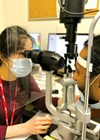Pratik Bikkannavar provides insights into the potential benefits a placement in ophthalmology provides General Practice Specialty Trainees (GPSTs) and its valuable purpose for the wider ophthalmic community.
Ophthalmic complaints are known to account for up to 1 in every 20 consultations in primary care [1]. GPSTs thus need to ensure they have a good knowledge-base and experience in the assessment and the management of common ophthalmic problems, in order to be well prepared for independent clinical practice as a general practitioner (GP).
With the great relevance of ophthalmology to general practice, placements in ophthalmology have been and continue to be available across the UK as a component of specialty training posts in general practice. Such placements have also been positively received by GPSTs historically [2].
With ophthalmology being for the large part an area of specialist practice, GPSTs in an ophthalmology placement will generally find themselves working in a supernumerary capacity, within the eye casualty or subspecialty clinic setting, under the supervision of a senior ophthalmic trainee or consultant. This to a good degree frees the GPST from service provision demands commonly associated with other hospital-based placements, and provides them a unique opportunity to focus extensively on their own personal development with a career in general practice in mind. This article explores what a GPST stands to gain by having a placement in ophthalmology as part of their training.
Broad knowledge-base in ophthalmology
A key benefit of a placement in ophthalmology for a GPST is clinical exposure to a wide range of ophthalmic pathologies. With this, the GPST can broaden their knowledge-base in the presentation, assessment and treatment of common ophthalmic conditions. Being able to draw upon such a wide knowledge-base will enable the GPST to deliver more comprehensive eyecare in the primary care setting in the future, and allow them to more effectively counsel and reassure any patients they refer to secondary eyecare, with regard to what the patient may expect to happen in hospital. This broadened knowledge-base is also beneficial in that it will enable better communication and understanding between a GP and teams in secondary or higher ophthalmic care. This will result in better integration of primary with higher ophthalmic care, better continuity of care, and may positively impact the patient experience and clinical outcome.
Furthermore, GPSTs in ophthalmology have the opportunity to be part of a patient’s entire journey through secondary eyecare, from presentation to treatment to follow-up. This clinical exposure to the entire patient journey will help the GPST to better understand and empathise with the experiences of future patients, notably those having conditions that cause chronic visual impairment. Pertinent examples include hereditary retinal diseases, diabetic retinopathy, and optic atrophy, which are the principal causes of severe and irreversible visual impairment among working-age adults [3]. Such understanding and empathy are essential for a GP, due to them contributing positively to the uniquely holistic and longstanding doctor-patient relationship that distinguishes a career in general practice.
Competence in ophthalmic assessment
With insufficient and inconsistent focus on ophthalmology in the undergraduate curriculum being a longstanding issue, current and prospective GPSTs are likely to report not having received adequate clinical exposure to ophthalmology as undergraduates [4]. As the vast majority of GPs also do not undergo any postgraduate training in ophthalmology, many understandably report lacking confidence in ophthalmic assessment [5]. Placements in ophthalmology as a part of GP training offer an invaluable means of remedying this crisis of inadequate training and practical experience in ophthalmology. In particular, clerking newly presenting patients in an eye casualty offers GPSTs the ability to gain confidence in obtaining a focused and comprehensive ophthalmic history, and competence in performing a thorough ophthalmic examination.
Furthermore, a key component of ophthalmic examination relevant to primary care is fundoscopy performed with a direct ophthalmoscope, an examination GPs report a lack of confidence in [6]. Its importance in primary ophthalmic care is highlighted by it being the only bedside ophthalmic clinical examination mentioned in the curriculum of The Royal College of General Practitioners that visualises the inner eye [7]. Patients routinely have their pupils dilated in eye clinics – in particular patients with suspected or known vitreoretinal pathologies requiring examination of the posterior segment. Such patients are ideal for GPSTs to hone their direct ophthalmoscopy skills on initially, before moving on to gaining further practice with patients that have undilated pupils.
Competence in ophthalmic triage
With GPs often being the first port of call for patients with an ophthalmic complaint, in addition to being able to adequately assess such a patient, a GP also needs awareness of the limits of their own knowledge and competence, and when it is appropriate to refer the patient to an ophthalmologist. Working in an eye casualty service allows for a GPST to gain competence in such triaging of ophthalmic complaints, both through active and passive learning. Active learning in this context refers to the GPST directly engaging in triaging referrals received by the eye casualty service, from sources including GPs and optometrists in the community, and clinicians working in the inpatient environment. Such triage work is routinely done under the supervision of a senior ophthalmic trainee or a consultant, whose vast knowledge and experience the GPST will be able to take advantage of. Additionally, being witness to patients’ journeys within an ophthalmology department may also allow a GPST to more passively develop awareness of the threshold for referral to secondary care.
Preparation for a portfolio career
A small number of GPs in the UK currently have a special interest or extended role in ophthalmology as part of their general practice. This role currently lacks standardisation and regulation, meaning that its scope is broad and undefined. This role may extend from a GP merely acting as a source of specialist eyecare advice within a practice, to a GP who runs specialist clinics dedicated entirely to this extended role. The scope of work a GP does in this role is largely dependent on their personal clinical experience in ophthalmology, and networking with higher ophthalmic care services to find or create suitable opportunities [8]. This extended role has much scope for promotion and development in that it may be able to take some pressure off secondary care ophthalmic services, which are currently overburdened and understaffed, thereby unable to cope with the ever-rising demand for services [9,10]. Being at the very beginning of their careers in primary care, GPSTs are ideally placed to start working on a portfolio career as a GP with an extended role in ophthalmology. A placement in ophthalmology will offer a GPST the opportunity to build both the clinical experience and the connections needed to lay the foundation for such a portfolio career.
TAKE HOME MESSAGES
-
Postgraduate training in ophthalmology is relevant to a career in general practice due to the frequency of patients with eye problems seen in primary care.
-
A placement in ophthalmology will allow a GPST to develop a broad knowledge-base and thereby provide more comprehensive and holistic eyecare in the community.
-
A GPST will develop their competence in bedside ophthalmic assessment and triage through a placement in ophthalmology.
-
A GPST seeking a career with an extended role in ophthalmology will find that such a placement offers an ideal and timely opportunity for CV building and networking.
References
1. Kilduff C, Lois C. Red eyes and red-flags: improving ophthalmic assessment and referral in primary care. BMJ Qual Improv Rep 2016;5(1):u211608.w4680.
2. Dayan MR, Fitt AWD, Bosanquet RC. General practitioner registrars’ opinions of general practice training in ophthalmology: A questionnaire survey in the Northern Region. Eye 1997;11(4):496–9.
3. Liew G, Michaelides M, Bunce C. A comparison of the causes of blindness certifications in England and Wales in working age adults (16-64 years), 1999-2000 with 2009-2010. BMJ Open 2014;4(2):e004015.
4. Baylis O, Murray PI, Dayan M. Undergraduate ophthalmology education - A survey of UK medical schools. Med Teach 2011;33(6):468–71.
5. Robinson A. Managing common eye problems in general practice. Prescriber 2017;28(2):22–6.
6. Shuttleworth GN, Marsh GW. How effective is undergraduate and postgraduate teaching in ophthalmology? Eye 1997;11(5):744–50.
7. GP curriculum: Clinical topic guides. Royal College of General Practitioners.
https://www.rcgp.org.uk/mrcgp-exams/
gp-curriculum/clinical-topic-guides
[last accessed May 2023]
8. Hornby S. Ophthalmic Services Guidance: Primary Care Ophthalmology Care (2013). The Royal College of Ophthalmologists.
https://heeoe.hee.nhs.uk/sites/
default/files/2013_prof_234_primary_care_
ophthalmology_care_june_2013_final1.pdf
[last accessed May 2023]
9. Workforce Census 2018 (2018). The Royal College of Ophthalmologists.
https://www.rcophth.ac.uk/wp-content/
uploads/2020/05/RCOphth-Workforce
-Census-2018.pdf
[last accessed October 2023]
10. Ophthalmology – the Hospital Eye Service in Crisis (2018). The Royal College of Ophthalmologists.
https://www.rcophth.ac.uk/wp-content/
uploads/2020/05/RCOphth-Workforce
-Census-Infographic-A4_2018.pdf
[last accessed October 2023]
Declaration of competing interests: None declared.
COMMENTS ARE WELCOME









